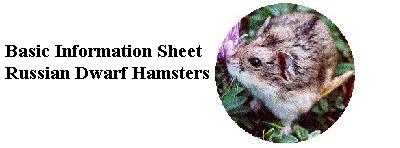
(Our thanks to Lorraine Hill for providing this useful information for Hamster lovers everywhere! This information is freely provided for use by Hamster owners, and may be copied for personal use, but may NOT not be published or sold in ANY form!)
There are two species of Dwarf Russian Hamsters: the Campbells Russian and the Winter White Russian (also known as the Siberian or Djungarian Hamster). The Campbells Russian exists in various colours, including the normal colour of mid-grey with a dark grey dorsal stripe, Albino (white with red eyes), Argente (ginger with red eyes), Black (near black with a jet black dorsal stripe), Opal (blue/grey with ivory belly), Mottled (white belly and white patches on the back), Platinum (white belly and top coat ticked through with white hairs) and dilute Platinum (white with black eyes). The Winter White Russian exists in the normal colour of dark grey with a jet black dorsal stripe and also exists in Sapphire (purple/grey with ivory belly), Imperial (with a whiter belly) and Pearl (white with coloured hairs ticked through).
SOCIABLE BEHAVIOUR
Dwarf Russian Hamsters are sociable and will live in pairs or groups making it possible to keep 2 or more single or mixed sexes in one cage. Although sociable it is important that hamsters are introduced to each other at a young age and before they have had the opportunity to become used to living on their own. They need not be from the same litter or same group of hamsters but when buying two or more to live together they should be roughly the same size and age and, in any case, under 3 months of age. Russian Hamsters establish an order of dominance and are prone to squabbles and these often sound much worse than they actually are and are merely a means of establishing or re-inforcing dominance. These squabbles rarely result in injury and are often more vocal than physical. If serious injury does occur it may be necessary to separate the hamsters into separate cages. Once a pair or group are separated there can be problems re-introducing them to each other.
EQUIPMENT
Dwarf Russian Hamsters are best kept in aquariums, rotastak/habitrail type cages or cages designed for mice where the bars are spaced closer together than normal hamster cages. They will require wood shavings to line the floor of the cage and shavings made from hard wood are best. Cedar shavings should be avoided as these cause irritation and allergic reactions in many hamsters. They will also require a dish for their food and a water bottle to provide them with a constant supply of water. Bedding material can also be provided and hay or shredded paper is best used. Avoid fluffy bedding material as this can become stuck in their cheekpouches, eaten and result in stomach blockages or get wrapped around limbs.
CARE
Although Dwarf Russian Hamsters are nocturnal they can be quite active for short periods during the day, but usually eat during the evening. Therefore they should be fed each evening and will require a handful of hamster mix and the occasional treat.
The cage should be cleaned each week, throwing away the old shavings, food and bedding material and replenishing with new. If the cage is to be washed this should be done using a disinfectant specifically designed for small rodents or using a very dilute solution of washing up liquid and rinsed thoroughly with water afterwards.
FEEDING
The basic requirement of the Dwarf Russian Hamster's diet is a well balanced dry hamster mix. Most pet shops sell hamster mixes and these consist of ingredients such as oats, barley, flaked peas, peanuts, sunflower seeds, dog biscuits, maize and rodent pellets. These mixes are designed to meet a hamster's nutritional requirements and although the hamsters may seem to favour some ingredients, for example sunflower seeds, it is important that these individual ingredients are not increased from that included in the basic mix as it will upset the balance of the mix and can lead to obesity and stomach upsets. Mixes designed for other animals should not be fed to Dwarf Hamsters as these could also cause stomach upsets and may not meet the nutritional requirements of the Dwarf Russian Hamster.
Fruit and vegetables can also be fed with carrots, apple, parsley, cabbage, broccolli, cauliflower leaves, pear, dandelion leaves, grapes being amongst the foods enjoyed by Dwarf Russian Hamsters. Lettuce should be avoided as too much can lead to liver complaints. In any case fruit and vegetables should be fed in small amounts as an occasional treat as too much can cause diarrhoea.
BREEDING
Breeding Russian Hamsters is not to be undertaken lightly as they are prolific breeders. The gestation period is 18-21 days and being sociable the male remains with the female during pregnancy and the rearing of the litter as he plays a role in the upbringing of the youngsters, although the female may banish him from the nest for the first couple of days following the birth. The average litter is 4-6 but up to 14 has been known and the female can have litters 18-21 days apart.
LIFESPAN
The average lifespan of Dwarf Russian Hamsters is 1.5-2 years although they can live longer and up to 4 years has been known.
ADDITIONAL INFORMATION
Step by Step Guide to Dwarf Hamsters by Chris Henwood, TFH Publications
Pet Owner's Guide to the Hamster by Lorraine Hill, Ringpress Books, UK
The Complete Hamster Site by Lorraine at Internet http://www.hamsters.co.uk
Copyright: Lorraine Hill 1997
Email: Lorraine@hamsters.co.uk
This Basic Information Sheet may be printed, copied and freely distributed for personal use including the distribution by pet stops to customers (but is not to be sold or published). All other rights are reserved and copying or use of all or any part of this Basic Information Sheet other than that stated shall be a breach of copyright.
Return to:
